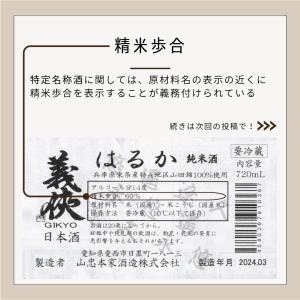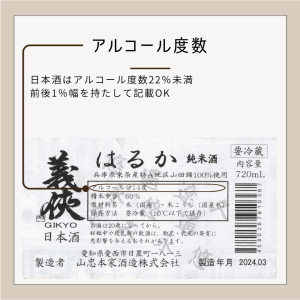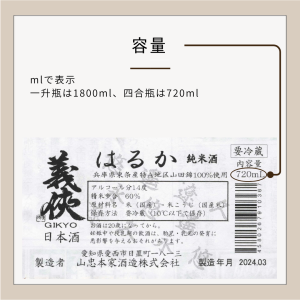みなさん日本酒のラベルをよく見たことはありますか?
日本酒のラベルは、消費者がお酒を買うときに分かりやすいように、記載しなければならないことが決まっています。
今回は特定名称酒と呼ばれる日本酒のラベルの内容を紹介していきますね。
日本酒の基礎を英語で知りたい方はこちらをどうぞ!
それでは順番に見ていきましょう!
ラベル記載必須事項
まずラベルに必ず記載しなければいけない項目です。
これらの項目は、ラベルの表か裏のどちらかに書かれています。
①商品名=product name(プロダクトネーム)
銘柄=brand(ブランド)
②特定名称=specially designated sake (premium)(スペシャリーディザグネイティッドサケ)
➂清酒 = sake(サケ)
④原材料 = raw ingredient(ローイングリーディエント)
⑤精米歩合 = rice polishing ratio(ライスポリッシングレイシオ)
⑥アルコール度数 = alcohol content(アルカホール コンテント)
⑦容量 = (bottle) size(ボトル サイズ)
⑧製造者名(酒蔵) = brewery(ブルーワリー)
⑨注意事項 = caution(コーション)
では順番に詳しく説明していきます。
商品名(銘柄)- Product Name (Brand)

もちろんラベルには商品名が書いてあります。
日本酒には銘柄名と商品名があり、商品名は銘柄名を含んでいることが多いです。
例えば、銘柄名が「義侠」、商品名は「義侠 はるか 純米酒」のような感じです。
Of course, the label has the product name on it.
Sake has a brand name and a product name, and the product name often contains the brand name.
For exapmle, the brand name is “Gikyo,” and the product name is “Gikyo Haruka Junmai-shu.”
特定名称 – Specially Designated Sake

特別な基準を満たしたお酒を特定名称酒と呼びます。
特定名称酒は8種類あるので、どれに当てはまるかを記載する必要があります。
The sake that meets certain criteria is called “specially designated sake,” which means premium grade sake.
The specially designated sake has 8 types, and breweries should indicate which type of sake it is.
清酒(日本酒)- Sake

日本酒か清酒のどちらかを必ず記載する必要があります。
“Nihonshu” or “Seishu” must necessarily be written on the label.
清酒」と「日本酒」の違い
「清酒」と「日本酒」の違いについても解説しておきますね。
清酒の方が大きなくくりで、米、米こうじ及び水を原料として発酵させて、こしたもの、が清酒。
清酒の中でも、日本産のお米を使用、日本国内で醸造したもの、を日本酒と呼びます。
“Seishu” is a broader category, defined as “that which is fermented from raw materials: rice, rice-koji, and water, and has then been strained.”
Sake made using rice from Japan and brewed in Japan can be referred to as “Japanese sake” or “Nihonshu.”
精米歩合 – Rice Polishing Ratio

精米歩合は日本酒の原料であるお米を磨く割合のことです。
お米の外側には栄養がたくさんありますが、それらがありすぎるとお酒の雑味に繋がるため、お酒の味わいには精米歩合が大きく関わってきます。
そのため、特定名称酒の場合は必ず精米歩合が記載されています。
“Rice polishing ratio” refers to the percentage of the grain that remains after part of the rice has been polished away.
The outer layers of rice contain an abundance of proteins, fats, minerals, vitamins, and other components, which might adversely affect the aroma and taste of sake.
Therefore, the rice polishing ratio is an important factor that influences the flavor of sake.
You should be able to find the rice polishing ratio on the label of premium grade sake.
英単語
・protein(s):タンパク質
・mineral(s):ミネラル
・vitamin(s):ビタミン
・component(s):成分
・adversely:逆に
原材料 – Raw Ingredients

日本酒の原材料は主に、水、お米、米こうじ、(醸造アルコール)です。
ラベルには水の記載が不要ですので、特定名称酒で表示されているのは、米、米こうじ、(醸造アルコール)の2つか3つです。
The raw ingredients of sake are water, rice, rice-koji, and sometimes brewer’s alcohol.
Water doesn’t have to be listed on the label, so only rice, rice-koji, and (if used) brewer’s alcohol are written on the label of premium sake.
アルコール度数 – Alcohol Content

日本酒のアルコール度数は22%未満でないといけません。
アルコール度数は12%から18%が多いです。
ラベルへ記載する場合、前後1%は幅を持たせて記載しても問題ありません。
The alcohol content of sake must be less than 22%.
The alcohol content is often between 12% and 18%.
When listing the alcohol content on the label, a margin of 1% more or less is acceptable.
容量 – Bottle Size (oz)

日本酒の容量は1.8L(一升瓶)、720ml(四合瓶)が一般的です。
海外ではoz(オンス)の表記がメジャーなので、換算しておきます。
1.8L = 60.86524oz (About 60.9oz)
720ml = 24.3461oz (About 24.3oz)
The typical sizes for Japanese sake are 1.8L (isshobin) and 720ml (yongobin).
1.8L equals about 60.9oz, and 720ml equals about 24.3oz.
製造者名

製造者の氏名、会社名、所在地の記載が必要です。
ちなみに、お酒を造っているところを蔵元と呼び、蔵元の名前と銘柄の名前が共通していることも多くあります。
The name of the brewer, the company name, and the location must be listed.
Just so you know, the company that brews sake is called “kuramoto.'” Many kuramoto use their company name as the brand name.
注意事項

注意事項がある場合は記載が必須です。
例えば、日本酒は高温や光で味が変化しやすいので、蔵が冷蔵管理してほしい場合は「要冷蔵」の記載をします。
If there are important instructions, they must be listed.
For example, since sake can easily change in taste due to high temperatures and light, if the brewery recommends refrigeration, it should be labeled as “keep refrigerated.”
まとめ
日本酒のラベルに書かれている内容を把握していただけたでしょうか?
日本酒のラベルの見方について、海外の人から聞かれた際に、役立てていただければと思います。
また今回は必須の記載事項について紹介しました。
任意の記載事項、記載してはいけないこと、というのもあるので、次回紹介していきたいと思います。
ここまで読んでくださってありがとうございました!
コメント